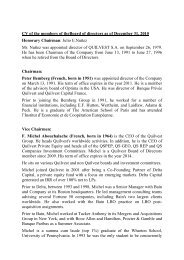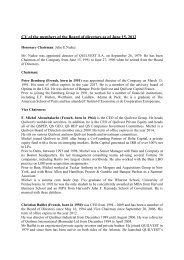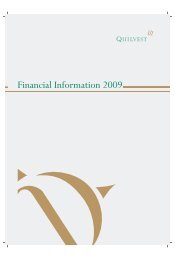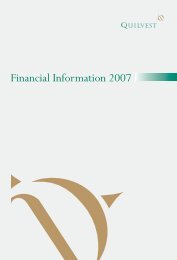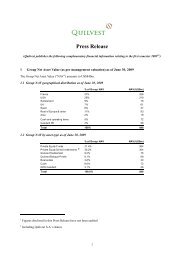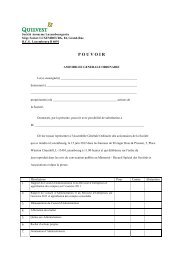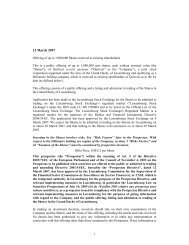Annual Report 2006 – Financial Section - Quilvest
Annual Report 2006 – Financial Section - Quilvest
Annual Report 2006 – Financial Section - Quilvest
You also want an ePaper? Increase the reach of your titles
YUMPU automatically turns print PDFs into web optimized ePapers that Google loves.
Significant Accounting Policies (continued)<br />
Impairment<br />
The carrying amounts of the Group’s property, plant and equipment, intangible assets, investments in associates and other<br />
financial assets are reviewed at each balance sheet date to determine whether there is any indication of impairment. If any<br />
such indication exists, the asset’s recoverable amount, being the greater of its fair value less costs to sell and its value in<br />
use, is estimated.<br />
Interest-bearing Liabilities<br />
Interest-bearing liabilities are recognized initially at cost, being the fair value of the consideration received less attributable<br />
transaction costs. Subsequent to initial recognition, interest-bearing liabilities are measured at amortized cost with any<br />
differences between cost and redemption value being recognized in the income statement over the period of the liabilities<br />
on an effective interest basis.<br />
Convertible Bonds<br />
<strong>Quilvest</strong> S.A. issued in 2003 a convertible loan that can be converted to share capital at a fixed predetermined conversion<br />
ratio at the option of the holder at the maturity date of June 30, 2008.This loan is accounted for as a compound financial<br />
instrument, net of attributable transaction costs.The equity component of the convertible loan is calculated as the excess<br />
of the issue proceeds over the present value of the future interest and principal payments, discounted at the market rate<br />
of interest applicable to similar liabilities that do not have a conversion option.This component is included in equity.The<br />
interest expense recognized in the income statement is calculated using the effective interest rate method.<br />
Employee benefit obligations<br />
The Group sponsors pension plans according to the national regulations of the countries in which it operates.The significant<br />
pension plans in France and Switzerland qualify as defined benefit plans under IAS 19.The respective employee benefit<br />
costs are determined in accordance with the Projected Unit Credit Method.Actuarial calculations are conducted on an<br />
annual basis. Any excess of the defined benefit obligation over the fair value of plan assets is initially recognized and presented<br />
under employee benefit obligations. A pension asset is recognized only to the extent that it represents economic<br />
benefits in the form of refunds or reductions in future contributions. Actuarial gains and losses arising from subsequent<br />
calculations are recognized to the extent that they exceed 10% of the greater of the defined benefit and the fair value of<br />
the plan assets. The amount exceeding this corridor is amortized over the average remaining working lives of the<br />
employees participating in the plan.<br />
The pension plan in Luxembourg is a defined contribution plan. The pension costs recognized during a period for such<br />
plans equal the contributions paid or due for that period.<br />
Provisions<br />
A provision is recognized on the balance sheet when the Group has a legal or constructive obligation as a result of a past<br />
event, and it is probable that an outflow of economic benefits will be required to settle the obligation.<br />
If the effect is material, provisions are determined by discounting the expected future cash flows at a pre-tax rate that<br />
reflects current market assessments of the time value of money and, where appropriate, the risks specific to the liability.<br />
14




